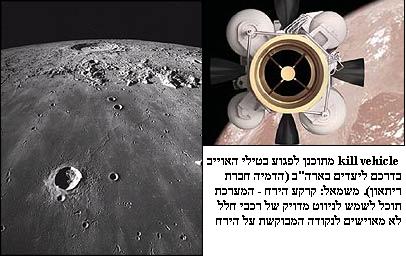The Raytown company plans to build cheap landers that will use the components of missiles designed to destroy the warheads of the US's enemies in the event that such missiles are launched.

Rocket crews home on the moon
An American company proposes to use the technology of guided missiles to make precise automatic landings on the moon. The Raytown company plans to build cheap landers that will use the components of missiles designed to destroy the warheads of the US's enemies in the event that such missiles are launched.
. The technology could be used in the low-cost missions that President Bush is planning for the moon and Mars. The engineers explained the idea at the American Geophysical Society conference in San Francisco.
On its way to the moon there will be a lander attached to the cruise stage of the rocket that will handle navigation and other tasks. The vehicle itself will use a re-plumbed version of the drive system used by Raytheon in kill vehicle missiles.
About two minutes before landing on the moon, a solid fuel engine will reduce the speed of the vehicle to 300-450 meters per second. The lander itself will activate its engines about a minute before impact. This would mimic an operational schedule used by missiles for several decades.
Landing will be brought to precise coordinates by a Digital Scene Matching Area Correlator (DSMAC). This instrument requires high-resolution images that are compared with a reference map of the landing site in real time. Data from the images and the height dimension of the vehicle are processed to help navigate the vehicle to its destination. The photographs taken on the way down can also help scientists study the geology of the landing area.
"NASA's landing requirements, especially when they want to land on the lunar surface, are becoming more and more precise," said Raytheon's Vice President of Advanced Defense Missiles, Michael Boen Booen. "Therefore, we have a very precise navigation ability to land anything exactly at the right coordinates."
The kill vehicles are a key component of the missile defense envelope that the Pentagon plans to deploy at a cost of billions of dollars to protect the US from missiles fired at its territory. They are designed to destroy these long-range missiles before they re-enter Earth's atmosphere. However, ground-based midcourse defense (GMD) systems were withdrawn on Wednesday due to the biggest failure of such tests in the last two years. The Hirvat missile automatically shut down on the launch pad due to an "unknown anomaly".
The lunar lander would be suitable for small, unmanned missions on the surface of the moon. Earlier this year, NASA awarded Raytheon a half million dollar contract to be part of a system of three companies participating in the study of the needs necessary to return to the Moon, as a first step before manned exploration of Mars and other planets. This work "polishing and refining the concept for carrying out space travel" is done under the Constellation project - a long-term effort to speed up manned exploration travel in space.
